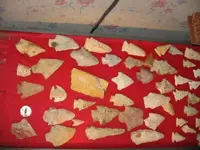Peter, that's a question a lot of people ask. Maybe I can explain it without going overboard, lol. When I get to talking about native american history, I can get carried away!

The patterns are consistent with the point type, and age. During different periods of time, different styles of points were made. There were several styles used simultaneously at different ages in time. Most of the points you see to the right (the smaller white colored points with a pronounced side notch at the bottom) are Bolen Bevels. These are the oldest in the group. This style was used as long ago as 12,000 years ago. That particular design was pretty much out of use around 8,000 years ago. It was a southeastern point style. During the same time frame, tribes in other parts of the country were using other designs, which varied from region to region. No one really knows why a design got widely adopted across a region like that, and why they stuck with a particular design for whatever length of time, but they did. It is nice though, because it gives you a ready indication of the age of the site you are hunting.
Some people ask how they know what points were in used 12000 yrs ago. The way this is determined is by excavating the sites in layers. Naturally, the deepest points are the oldest. Layer after layer is excavated, and artifacts from each layer are kept seperate and soil samples of each layer are kept. Carbon 14 dating is used on organic matter from fires in the layer and discarded bones from meat, etc.... This gives the date for the particular layer. Then this is done over several sites, and eventually a good determination of the age of each point type is understood. The bolen bevel points are among the oldest in my area. There are older points around, but they are rare. Most any points older than these bolen bevels would be paleo points, and paleo point styles usually have a much broader range across the country, rather than being localized in regions. Clovis points for example, can date to 30,000 years old. They are thought to have been used by the same man (men) who crossed the bering strait. These can be found anywhere from alaska to florida. I think this is indicative of nomadic individuals or small groups with little communication between groups.
By the archaic period, these groups began to form larger groups and communicate better and the point styles started becoming more localized and a wider variety of types began appearing.
Maybe that's more than anyone wanted to know, but hope that helps!


 before I met Jesus and got clean
before I met Jesus and got clean  . I could kick myself now.
. I could kick myself now. j/k
j/k


